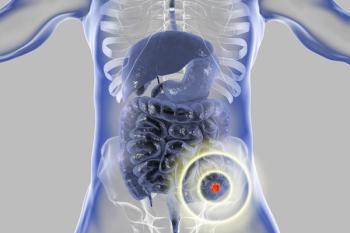
Oncology NEWS International
- Oncology NEWS International Vol 16 No 3
- Volume 16
- Issue 3
Oxaliplatin Safe to Add to Preop CRT in Rectal Ca
Preliminary findings from Italian researchers show that adding oxaliplatin (Eloxatin) to preoperative chemoradiotherapy (CRT) for rectal cancer is feasible and safe, and does not adversely affect the ability to carry out subsequent surgery.
ORLANDOPreliminary findings from Italian researchers show that adding oxaliplatin (Eloxatin) to preoperative chemoradiotherapy (CRT) for rectal cancer is feasible and safe, and does not adversely affect the ability to carry out subsequent surgery. If proven effective, the addition of oxaliplatin in this setting could become an important new tool for treating the disease, said Carlo Aschele, MD, PhD, lead clinician in Colorectal/Gastrointestinal Cancer in the Department of Medical Oncology and Cancer Prevention, E. O. Ospedali Galliera, Genoa. He presented the findings at the 2007 Gastrointestinal Cancers Symposium (abstract 233).
Neoadjuvant chemotherapy and radiation are often used before surgery to shrink rectal tumors and render them more amenable to resection. Recently, oxaliplatin has been shown to increase the efficacy of chemotherapy in both early-stage and advanced metastatic colon cancer, and the Italian researchers decided to see if its addition would be safe in the setting of rectal cancer, Dr. Aschele said on behalf of his coinvestigators in the Studio Terapia Adiuvante Retto (STAR) study group.
"More than 30% of rectal cancer patients develop distant metastases despite optimal surgery and fluorouracil (5-FU)-based chemoradiation, and complete surgical removal of big rectal tumors is difficult and often requires the placement of a permanent colostomy. We know that oxaliplatin increases the shrinkage of unresectable liver metastases in colon cancer and also lowers the risk of developing metastases after surgery, and it also increases the antitumor activity of radiation, as shown in animals," he said.
Researchers for the open-label, randomized, multicenter trial have enrolled 421 of a planned 800 patients, all with cT3-T4 and/or cN+ resectable rectal cancer. Patients were required to have resectable tumors located within 12 cm of the anal verge, as well as radiological evidence of perirectal fat or regional node involvement. No patient is older than age 75. Patients are being randomized to receive infused 5-FU (225 mg/m
2
/d) plus external-beam pelvic radiation (50.4 Gy in 28 daily fractions) or the same regimen plus weekly oxaliplatin (60 mg/m
2
weekly X 6). Surgery is scheduled 6 to 8 weeks after completion of chemoradiotherapy.
Safety Findings
Dr. Aschele reviewed safety data from 313 evaluable patients to date. The most common side effects were gastrointestinal. Diarrhea occurred in 63% of the oxaliplatin arm vs 48% of the 5-FU-only arm. Nausea occurred in 36% and 19%, respectively, and vomiting in 24% and 5%. Neutropenia and thrombocytopenia were slightly increased in the oxaliplatin arm. Radiation dermatitis was not increased by adding oxaliplatin. He noted that 38% of the oxaliplatin patients experienced neurosensory problems vs none of the patients on 5-FU alone.
"We expected that oxaliplatin would be associated with more side effects, including the neurotoxicity. But, except for diarrhea, there was no significant increase in severe grade 3 and 4 side effects with oxaliplatin," Dr. Aschele said. Grade 3-4 diarrhea occurred in 17% of oxaliplatin patients vs 7% of 5-FU only patients. "There were no unexpected major side effects," he added.
Dose Completion Rates
Two-thirds of the oxaliplatin patients received all six of their oxaliplatin courses, and 87% received at least four courses. "More than 90% of patients in both arms received at least four courses of 5-FU (97% for 5-FU alone vs 91% for oxaliplatin)," he said, adding that 85% vs 70%, respectively, received all 5-FU courses. Most patients completed 90% to 100% of the total planned radiation therapy dose (96% of 5-FU vs 91% of oxaliplatin patients), and 98% vs 95% completed up to 89% of the planned dose.
Surgery was not delayed because of the addition of oxaliplatin (time to surgery from the end of treatment was 51 days for 5-FU vs 52 days for oxaliplatin), he said, and the percentage of patients undergoing surgery was approximately the same in both arms: 98% for 5-FU vs 96% for oxaliplatin.
Accrual is continuing, he said, to assess the effect of oxaliplatin on local tumor shrinkage and survival. "The doses of oxaliplatin used in this study are in the same range as those used in the treatment of metastatic cancer, and thus are likely to be active in this population of patients as well. That certainly is our hope," Dr. Aschele concluded.
Articles in this issue
almost 19 years ago
Peptide-Based Breast Ca Vaccines Promising in Early Trialsalmost 19 years ago
Diagnostic Dilemma: GI Diseasealmost 19 years ago
Imatinib Responses in CML May Take Timealmost 19 years ago
IV Vidaza Approved; Oral Formulation to Be Testedalmost 19 years ago
Study Confirms Avastin Advantage in Advanced NSCLCalmost 19 years ago
Legal Services Should Be a Component of Standard Cancer Carealmost 19 years ago
Mouse Virus Evidence Suggests Viral Basis for Breast Caalmost 19 years ago
Groups Oppose Ruling on Access to Experimental Drugsalmost 19 years ago
Satellite Allows Digital Mammography Screening for Rural Native Americansalmost 19 years ago
Nexavar Effective in Advanced HCC: Phase III Trial StoppedNewsletter
Stay up to date on recent advances in the multidisciplinary approach to cancer.

















































































